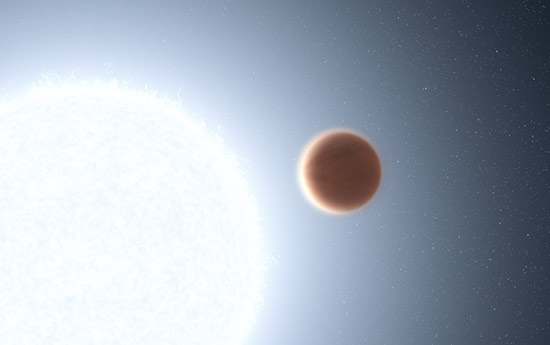epistellar Jovians

An artist's illustration of the planet KELT-20b which orbits a blue-white star. The giant planet is so close to its star (8 million km) the torrent of ultraviolet radiation from the star heats the planet's atmosphere to over 1,650 degrees Celsius. This creates a thermal layer where the atmosphere increases in temperature with altitude.
Epistellar Jovians, also known as "hot Jupiters", are exoplanets, similar in mass to Jupiter, with remarkably small, circular orbits around their central stars and orbital periods of less than 10 days. The discovery of this class of planet was unpredicted and has compelled theorists to reconsider and refine their models of planet formation (see planetary systems, formation). The prototype epistellar Jovian is the 0.44 Jupiter-mass planet detected around 51 Pegasi, with an orbital radius of less than one eighth of Mercury's distance from the Sun. Some presently known examples are listed below.
| host star | mass (Jup=1) | orbital radius (AU) | period (d) |
| HD 75289 | 0.42 | 0.046 | 3.51 |
| 51 Pegasi | 0.47 | 0.050 | 4.23 |
| HD 187123 | 0.52 | 0.042 | 3.10 |
| upsilon Andromeda | 0.68 | 0.057 | 4.61 |
| HD 217107 | 1.28 | 0.04 | 7.11 |
| tau Bootis | 3.87 | 0.046 | 3.31 |
The surface temperatures of these worlds are believed to range from about 1,000 to 1,700°C (1,800 to 3,100°F). Although it is conceivable that they are enormous balls of rock and metal, it seems much more likely that they are gas giants, similar in composition to Jupiter. Calculations show that even at such high temperatures, the large gravitational pull of these planets would allow them to retain a massive hydrogen atmosphere with ease. The main difficulty for astronomers lies not in explaining how epistellar jovians could survive in such small orbits, but how they came to be there in the first place. Conventional theory suggests that giant planets should only be able to form in the cooler outskirts of a protoplanetary disk. In an effort to accommodate the new findings, astronomers Douglas N. C. Lin and Peter Bodenheimer, of the University of California, Santa Cruz, and Derek C. Richardson of the University of Washington, have extended the standard model by suggesting that a young protoplanet condensing out of a protoplanetary disk will carve a groove in the disk, separating it into two sections.1 They theorize that the inner disk will lose energy through friction, causing the disk material and protoplanet to spiral in toward the central star. As the protoplanet draws nearer it will cause the surface of the star to bulge. The rapid rotation rate of the young star, however, means that this bulge will tend to move ahead of the planet, tugging it forward and tending to whip it into a larger orbit. An epistellar Jovian, according to this model, moves in a small, stable orbit, subject to two equal and opposing forces-the drag of the inner protoplanetary disk and the young rotating star's forward tug.
For a planet in such a small orbit there is a significant probability (about 5 to 10%) that it will transit in front of its primary as seen from Earth and therefore be detectable by photometry. This is highly significant because data obtained from photometric observations of a transit will allow a direct measurement of the mean density of the planet and therefore its nature to be established.
Reference
1. Lin, D.N.C., Bodenheimer, P., and Richardson, D.C. "Orbital Migration of the Planetary Companion of 51 Pegasi to Its Present Location," Nature, 380, 606 (1996).


